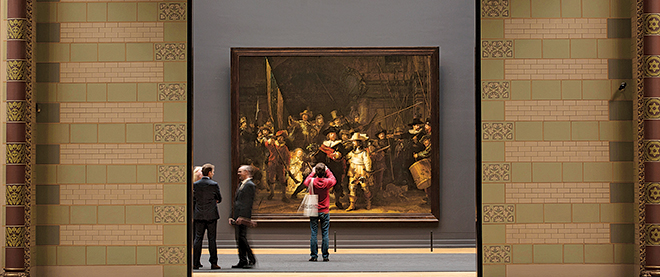149 paintings to see in Europe
Canada’s most famous libel lawyer reveals himself the perfect guide to Europe’s museums
Michael Kooren / Reuters
Share

There is a part in Julian Porter, Q.C.’s lively—to put it mildly—book on European art, 149 Paintings You Really Need to See in Europe (So You Can Ignore the Others), that neatly catches the two most passionate of his many interests. Porter, 76, is one of the most prominent libel lawyers in Canada and, for decades, a chief bulwark of defence for media outlets, including Maclean’s, and individual writers such as Allan Fotheringham, to cite one who really appreciated the help. Porter is also someone who has regularly visited European art galleries for nearly 60 years, often annually, to immerse himself in Rembrandt’s self-portraits and other favourite works.
So Porter is happy to write, and talk, about James Whistler’s libel trial. When the famous painter was affronted in 1877 by the equally famous critic John Ruskin, who called one of Whistler’s (now) celebrated “nocturne” paintings the equivalent of “flinging a pot of paint in the public’s face,” the London-based American artist sued. “The record is riveting,” laughs Porter. “Whistler kept being interrupted by this mean old boob of a British judge, Baron Huddleston, who could not understand what was in the painting, let alone Whistler’s idea of ‘art for art’s sake.’ ” (The highlight of the exchange between jurist and painter: “The prevailing colour is blue?” “Perhaps.”)
Whistler won his case, although prevailing public opinion can be gauged by the one-farthing damages the jury awarded him, but he did much better in the judgment of posterity, his concept becoming, as Porter writes, “the central plank of 20th-century painting.”
Talking about Whistler’s disdain for photograpic-level representation in painting leads Porter to Joseph Turner, and memories of visting a Turner exhibition at the Louvre in Paris in 1989. “I went with Adrienne Clarkson, whom I was staying with, and I remember how mad the French were at Turner for being so far ahead of the Impressionists.” And Turner brings Porter, as most artistic conversations do, to the painter he truly loves, Rembrandt. “I was just there in Amsterdam, at the Rijksmuseum looking at his Jewish Bride—you can see the abstract in that—and you can see the distant birth of Impressionism in Rembrandt’s portrait of Jan Six.”
Porter’s book, he says, is meant for “bright people who haven’t had the time,” or his opportunities; he’s been at it since he was a teenaged guide for visiting Canadian students in Europe in the 1950s. To that end, the 149 showcased works include the generally recognized classics, even if Porter has dissident, at times curmudgeonly, views on them. Vermeer’s Milkmaid receives praise, for instance, even if Porter can’t understand how the Rijksmuseum’s curators can describe it as the “hit” of their institution, when it has to compete with “the mighty Rembrandt in full flight.”
Time is also of the essence in 149 Paintings: There is advice on the quickest way into the Louvre (via a little-used entrance at the Porte de Lions), and a sharp warning not to waste eyesight and brain space on lesser works. Not that his advice is followed close to home. “I tell Anna,” he says in reference to his wife, publisher and author Anna Porter, “don’t look left, don’t look right, head straight to the major stuff. But soon enough, she’s three rooms behind, caught in front of some little Italian angel.”
Porter’s book is at its most entrancing, though, as a record of one acute observer’s ever-changing reactions to a handful of Rembrandt self-portraits. Time and again, Porter records new thoughts as he, too, approaches the age of the artist when he painted himself. The last of Rembrandt’s 80-odd self-portraits was done in 1669, a year after his beloved son Titus died, and shortly before his own death at 63. “The left eye has a gleam, the right is murky. Above the upper lip a smear of white. When you are near death, who cares?” Porter used to agree with the critical assessment that saw Rembrandt depicting himself as a survivor, a man of triumphant inner strength. Now, no more: “I see sadness, or is it pain?” Great art, Porter would still agree, is made great by its capacity to surprise.